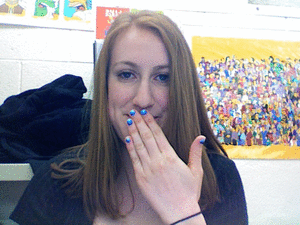Overall, I hope my love of sign language was conveyed in the Ted Talk. I am sad to see this project end, because it was probably the most enjoyable project I was ever assigned, but know that I will continue to further my knowledge of sign language.
Personally, I would rather not grade myself for this Ted talk because I feel like grades go against the whole foundation of this project. Grades are extrinsic motivation, and to learn ASL I was motivated solely intrinsically. I also know that personally, I am my own worst critic. I am always way harder on myself than anyone else could possibly be. When it comes to grades, I never have an accurate depiction of "how well I did".
That being said, I have absolutely nothing against reflecting on what you have done, how hard you have worked, and how much you have learned. In fact I think it's necessary to grow.
Our Ted Talk I think went well. No major mess-ups. I think we were within the time limits, although I'm worried we might have gone over. We didn't just give a run through of our process, and instead had an overarching message, which I think is what you were looking for. I made the powerpoint, and spent a bit of time on the conversation part in order to help the audience understand, and I think that was good for a visual component. I practiced my script and tried not to rely on my note cards. Friends told me after that it seemed polished, so hopefully the delivery was good.
I think the entire project went very very well. I now feel extremely confident in my abilities to converse in ASL. If I saw a deaf person on the street I would approach them and sign to them, and that is what I was hoping to get out of this project.
If I had to grade myself on the Ted Talk, I guess I would say anywhere from 25-27/30.
Overall, I really liked how much of the project was graded on the process. It really allowed me to focus on what I loved about sign language, instead of making me get stressed out over grades. I loved this project, and hope you continue to assign it in following years. Thank you!
 thank you!!
thank you!!

